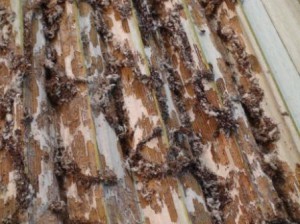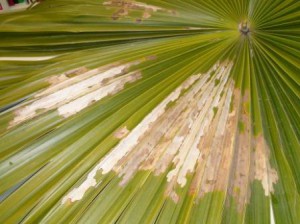 The palm leafskeletonizer, Homaledra sabalella
The palm leafskeletonizer, Homaledra sabalella
is a Florida native. The skeletonizer life cycle is egg, caterpillar, pupa, and adult moth. the caterpillar stage is the most plant damaging life stage. It feeds as an individual or in groups under the protection of woven silken tubes mixed with frass (caterpillar poop). The skeletonizer consumes the palm leaf surface leaving behind a the bare bones of veins and midribs.
Mainly the damage caused by palm leaf skeletonizer is considered to be AESTHETIC causing the palm frond to brown out. Healthy palms can survive the damage.

Management methods include: allow the beneficial insects parasitoids to attack the caterpillars. Keep the palm healthy through proper watering and fertilization practices. If the skeletonizer damage is severe try a strong stream of water to hose off the webbing with caterpillars and pupa. Prune fronds but limit the amount of green frond removal, each frond is a food source feeding the palm. The last resort is using chemical pesticides. Always start with the least toxic product to lessen the depopulation of beneficial insects. At this time research is being done on a variety of products but no one control has been reported to be supremely effective: foliar treatment of neem seed extract (Howard, in Ornamental Palm Horticulture, 2000) Dipel2x, and Sevin (Meerow, Betrock’s Guide to Landscape Palms, 1992). Keep in mind that all product labels need to be read and follow all label directions.
For more information see:
http://okeechobee.ifas.ufl.edu/Skeletonizer.pdf
http://www.fshs.org/Proceedings/Password%20Protected/1999%20Vol.%20112/247-250%20(WEISSLING).pdf
These links were current as of April 2013.
Photo Credit:
Kim Gabel
 0
0
